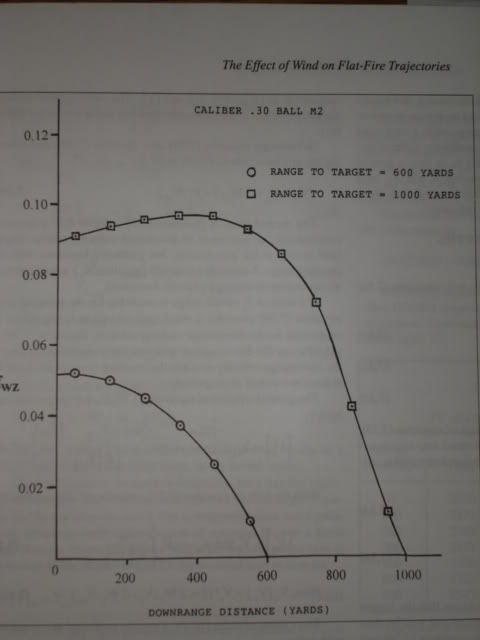wind
Interesting discussion.
Louis, I know exactly what Figure in McCoys book you're talking about, I'm trying to attach a scan of it (a pictures worth 1000 words).
In the scanned figure, the y-axis (fwz) represents the sensitivity of the bullet to wind deflection at the particular range.
Basically, I don't think there is a real disagreement here. The following statements about wind sensitivity are true:
Wind in the first half of the trajectory always is more important than wind in the second half of the trajectory.
Wind in the first 100 yards is always more important than wind in the last 100 yards.
This statement is sometimes true:
The wind in the first 100 yards is more important than any other segment.
The previous statement is true for ranges up to around 600 yards. When going beyond that range (around 1000 yards) the bullet is actually slightly more sensitive to wind around 400-500 yards than the first 100 yards.
In the case of long range (1000 yards), where the wind is more important at 400-500 yards, it's only slightly so as you can see in the scan.
The reason for this behavior in wind sensitivity is the following:
Wind deflection is related to the 'lag time' of the bullet. This is the difference between the actual time of flight and the 'vacuum' time of flight assuming no velocity loss.
For example, the 'vacuum' time of flight for a round fired at 3000 fps to 1000 yards it 1.000 seconds. (3000 fps for 3000 feet). The actual time of flight is closer to 1.500 seconds, meaning the lag time is 0.500 seconds.
Now, if the bullet had a constant drag coefficient for all flight speeds, the lag time and wind sensitivity would be the same for every 100 yard interval. However, since the drag coefficient increases as the bullet slows down, there is more lag time for slower speeds. This results in more sensitivity to wind drift down range.
However, that's not the whole story. Wind deflection that occurs near the muzzle will have more of an effect because the bullet spends more time on the deflected path. This is the intuitive effect that Ray mentioned.
In reality, it is the combination of the above two effects that result in the behavior observed in the attached Figure. At close range (600 yards), there hasn't been enough velocity loss for the difference in lag time to be the 'dominant' factor. At long range the difference in lag time overpowers the 'intuitive' effect of near wind, if only slightly.
In the end, I agree whole-heartedly that coping with wind deflection in shooting matches is far less of a science and more of an art. Louis's example of the outfielder is terrific. The fluid nature of wind just doesn't lend itself to prediction by classical means. It's one of the things that makes our sport interesting!
Take care,
-Bryan


